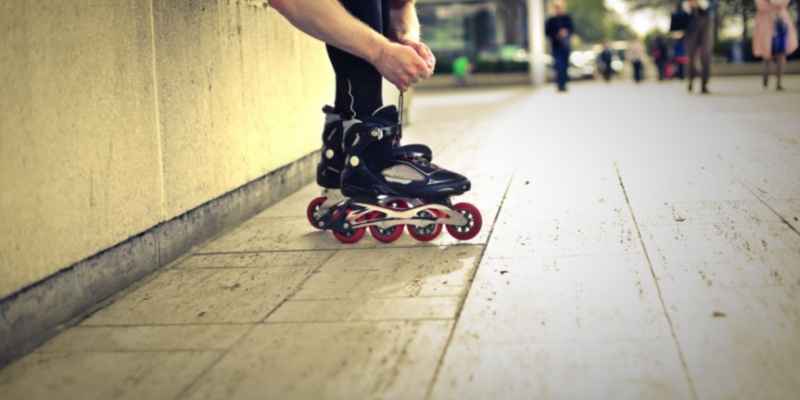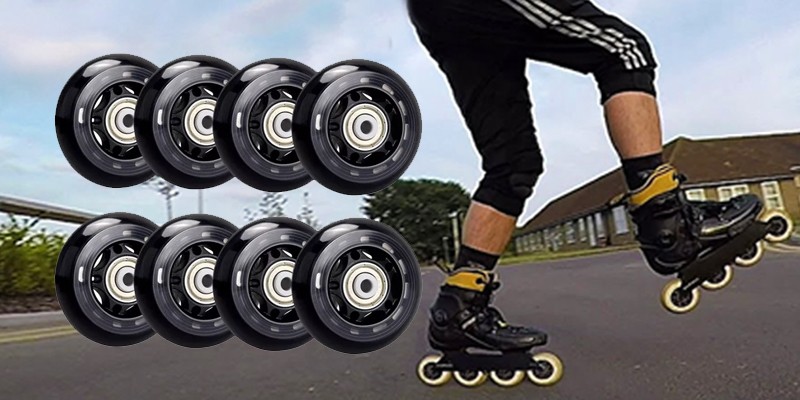In most sports, everyone uses the same kind of equipment to keep the playing field level. But in inline speed skating, you might’ve noticed that some racers skate with three wheels while others skate with four.
Skate configurations are a matter of personal preference in competitive speed skating. In competition, there are certain guidelines and restrictions, but skaters are permitted to use either three-wheel or four-wheel configurations, and different configurations are more or less popular depending on the race format. Here’s a little bit about each type of skate to help you decide which one might be right for you.

Three-wheel skates, also called tri-skates, are designed for high-speed skating. They’re lighter than four-wheel skates, so they can reach higher speeds more easily. However, tri-skates are less stable than four-wheeled skates, so they’re not the best choice if you’re not an experienced skater.
Four-wheeled skates, on the other hand, are more versatile. They can be used for speed skating or recreational skating, and they’re also a good choice for beginner inline speed skaters. A four-wheel skate is more stable than a tri-skate, so they’re easier to turn and stop. However, they’re not as fast as tri-skates because they have more rolling resistance.
So, which type of skate is right for you? If you’re looking for the answer, read on, as we compare the pros and cons of each type of skate.
How Many Wheels on the Skate: It Makes a Difference
The number of wheels on a roller blade does matter, depending on the skating style you want to do. If you’re looking for more stability, more speed, or more maneuverability, different wheel arrangements will give you those results.
3-wheel skates are most often seen in speed skating. They have three wheels in a narrower frame, which gives you more surface area touching the ground for better maneuverability and more speed. 3-wheel skates have a higher center of gravity because the bigger wheels cause a higher profile. This makes them more likely to tip over, which is why they’re not recommended for beginners.
4-wheel skates have four wheels in a wider frame. The extra width gives you more stability, and the extra wheels give you more contact with the ground, which makes stopping and turning easier. 4-wheel skates have a lower center of gravity because the smaller wheels create a lower profile.
4-wheel skates are going to be your best bet for beginner skate users or those who want to do more tricks. That’s because they’re much more stable than 3-wheel skates. With four wheels evenly spaced out under your feet, it’s easier to make quick turns and change directions. So if you’re just starting out with a straight line or you want to be able to do some fancy footwork, 4-wheel skates are probably the best choice for you.
Difference Between Stability and Maneuverability Regarding Inline Skates
Most inline skates come in a variety of shapes and sizes, each designed for a specific purpose. For example, racing skates are typically long and narrow, while freestyle skates are shorter and have a longer frame.
However, the two most important factors to consider when choosing inline skates are stability and maneuverability.
Stability is determined by the width of the frame and the number of wheels. A longer frame and more wheels provide greater stability, but they also make the skate less maneuverable.
Maneuverability is determined by the length of the blade and the distance between the front and rear wheels. A shorter blade and a shorter frame make the skate more maneuverable, but they also make it less stable.
When choosing inline skates, it is important to strike a balance between stability and maneuverability. Depending on your skating style, one may be more important than the other.
For example, beginners may prefer a four-wheel skate that is easy to control, while experienced skaters may prefer a more maneuverable skate that allows them to perform tricks and tight turns.
Ultimately, it is up to you to decide what trade-offs you are willing to make in order to get the right skate for your needs.
Wheel Size Makes a Difference, Too
Tri-skates usually have larger wheels than a four-wheel skate. This is because larger wheels roll faster and provide a smoother ride. In addition, big wheels are better able to handle bumps and obstacles.
However, a four-wheel skate is generally better for beginners and casual skaters. This is because they are easier to balance and provide more stability.
The amount of wheel making contact with the ground affects the speed and use of three vs four-wheel inline skates in several ways.

Larger wheels have more contact per wheel but contrast with 4 smaller wheels’ surface contact. The more contact a wheel has with the ground, the more friction there is between the wheel and the ground, and the slower the skater will go.
However, if the wheel is too small, it will not make enough contact with the ground and the skater will not be able to go fast enough.
So, if you’re a beginner skater, you may want to choose a skate with four wheels. But if you’re looking for speed and performance, a three-wheel skate with bigger wheels is the way to go.
Tri-Skates Are More Difficult to Learn for Beginners
Rollerblading is a popular pastime for people of all ages. However, beginners often find it difficult to master the basics of three-wheel inline skates.
There are several reasons for this.
Three-wheel inline skates are generally less stable than four-wheel skates. This means that they are more likely to tip over, making it difficult to keep your balance.
Tri-skates often have a narrower wheelbase than four-wheel skates. This makes them more difficult to turn and maneuver. Three-wheel skates have less contact with the ground than four-wheel skates. This makes them less stable at high speeds and more likely to lose traction.
With three-wheel skates, your body motions have to be much more exaggerated in order to keep yourself balanced. You really have to lean into your turns, and it takes a lot of practice to get the hang of it.
By contrast, four-wheel inline skates are much easier to maneuver. You can make smaller body motions and still stay balanced, and turns are a breeze. Of course, once you master three-wheel skates, they can be just as fun as four-wheel inline skates – it’s all about finding your skating style!
For these reasons, beginner inline skaters should start with four-wheel skates before moving on to tri-skates.
Factors Affecting Cost
When it comes to inline skating, there are two main options: three-wheel and four-wheel roller skates. Each option has its own advantages and disadvantages, which can affect the price. Here are some of the main factors to consider when choosing between three-wheel and four-wheel skates.
One of the biggest factors affecting price is the number of wheels. Three-wheel skates generally have fewer bearings and a simpler design, which makes them less expensive. Four-wheel skates tend to be more complex, with more bearings and a more sophisticated design. This usually makes them more expensive than tri-skates.
Another factor affecting price is the size of the wheels. Tri-skates tend to have larger wheels, which makes them more expensive. Four-wheel skates usually have smaller wheels, which makes them less expensive.
Finally, the type of skating you plan on doing can affect the price of your skates. If you plan on doing a lot of tricks or jumps, four-wheel skates will be a better option since they’re less likely to tip over.
In the end, the number of factors that affect cost can be daunting, but the prices are similar enough that it comes down to what you need out of your inline skates.
Which Is the Best? Three-Wheel or Four-Wheel?
In the end, the best inline skate for you is the one that meets your needs. If you’re looking for speed and performance for aggressive skating, three-wheeled skates are the way to go. If you’re just starting out, you may want to choose a skate with four wheels.
Both skate styles are worth your time, so it’s really up to you to decide which one is the best for you. No matter which you choose, inline skating is a great way to exercise, have fun, and enjoy the outdoors!
So, which is the best inline skate for you? It all depends on your skating style!





